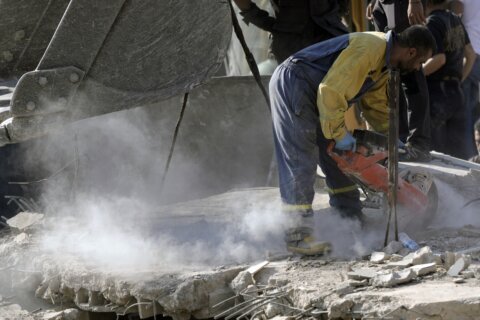Security deposits are a common requirement for renters, and typically, they amount to a full month’s rent or sometimes even two or three months.
Though you may get this back upon move-out, your landlord can also use it to repair any damage you do to the property — aside from normal wear and tear — or to cover missed rent. This can significantly reduce the amount you’re refunded or, in some cases, even deplete your security deposit entirely.
According to a survey from security deposit platform Roost, only 41% of renters expect to get their full deposit back upon moving out. Do you want to make sure you’re one of them? This guide can help.
In short, if you want to get your security deposit back, experts recommend you:
1. Take a thorough inventory of damage before moving in and document it all with photos and video.
2. Clear all your items, trash and personal belongings from the home at move-out.
3. Clean the property thoroughly, including inside cabinets and closets.
4. Stay up to date on your rent.
5. Keep the property in good condition, and fix damage as it occurs.
6. Request a move-out inspection and walkthrough with your landlord, so they can point out any repairs you need to address before moving out.
Mistakes That Can Cost You
Landlords can use security deposits to repair any damage done to the property, leaving furniture behind, skipping rent and a whole host of other issues — basically anything necessary to return the unit to its original condition.
“We allow for reasonable wear and tear, but if the apartment is not returned to us in near the same condition it was at move-in, there will likely be charges,” says Albert Lord, founder and CEO of real estate investment firm Lexerd Capital Management.
Here’s a full list of items you may be charged for when moving out:
— Stained carpets or damaged flooring.
— Unauthorized wall paint (or colors).
— Leaving behind furniture, food, trash, personal items or general messes.
— Damage done by pets.
— Foul odors.
— Outstanding utility bills.
— Overdue rent.
— Unauthorized alterations.
— Damaged walls.
It Pays to Hire a Professional
That last one — damaged walls — is the most common security deposit reducer, according to the Roost.com survey. This damage can include holes in the wall, chipped paint and, often, issues caused by poorly hung artwork or televisions.
“Definitely hire a professional to hang any TVs or large art,” says Phillip Salem, a real estate agent with Compass in New York City. “I have seen it too many times: Tenants try and do this themselves and leave more damage on the walls — and sometimes floors — than it would have cost for a one-hour handyman to stop by.”
[READ: What You Should Know About Rising Average Apartment Rents]
How to Maximize Your Security Deposit Refund
If you want to avoid having your security deposit withheld — even partially — at move-out, experts say there are a few strategies that can help.
Document the Apartment’s Condition Before Moving In
First, do a full inventory of any existing damage before moving, document it and share that documentation with your landlord.
“When you move into a new apartment, always take photos and videos of any damage to make sure it’s clear what the condition of the rental was when the tenancy started,” says Dan Mishin, founder and CEO of rental marketplace June Homes.
Clean, Clean, Clean
You should also clear out the property fully and make sure it’s clean from top to bottom. If you don’t have the capacity to do it yourself, consider hiring a cleaning service.
“Tenants should leave the apartment in ‘clean broom’ condition; this includes cleaning out the fridge, kitchen cabinets and bathroom cabinets and removing all personal items, including furniture, A/Cs, etc.,” says Adjina Dekidjiev, a real estate broker with Coldwell Banker Warburg in New York. “I’ve also seen many tenants leave furniture behind assuming that the owner will dispose of it — not realizing they’re liable for the disposal cost.”
Make Sure You’ve Paid Rent and Request a Final Walkthrough
Finally, stay up to date on your rent, take care of the property and fix any damage that occurs in real time. Once you’re ready to move on from the property, request a move-out inspection and walkthrough with your landlord.
“This provides the tenant the opportunity to speak with the landlord and compare the photos to any damage the landlord claims,” says Zachary Schorr, a real estate attorney with Schorr Law in Los Angeles. “The tenant can then also fix items needing repair before moving out.”
What to Do if Your Landlord Withholds Your Security Deposit
If your landlord does decide to withhold part or all of your security deposit, ask them for an itemized list of the damage, as well as the charges associated with them. Make sure you’re not being charged for normal wear and tear and that your landlord is considering the age of any damaged items when calculating their replacement or repair cost.
As Schorr explains, “Most items in a residential lease have a useful life. The landlord can’t charge the tenant for the full value of the damage if the item damaged is near the end of its useful life. In those circumstances, the landlord must prorate the damage based on the remaining useful life.”
If your landlord charges you for damage that already existed at move-in, show them your original inventory list and photos. They may be willing to waive that charge if you can prove it was preexisting.
“Pictures are going to really help in case a controversy over the deposit exists,” says Richard Ricciardi, an attorney with Powell, Jackman, Stevens & Ricciardi in Fort Myers, Florida.
If that doesn’t work or there’s another disagreement about the handling of your security deposit, speak to a local legal professional and consider filing an objection.
“Once an objection is filed, a small claims case can be initiated to have a judge decide on the return of the deposit,” Ricciardi says. “Outside of working out a compromise with the landlord, filing an action for a court to make a determination on the deposit is the only other option.”
More from U.S. News
6 DIY Projects You Can Tackle in a Weekend
When Will Housing Prices Drop?
6 Expert Tips to Get Your Security Deposit Back originally appeared on usnews.com
Update 07/14/23: This story was published at an earlier date and has been updated with new information.







